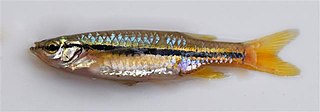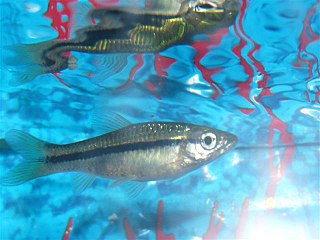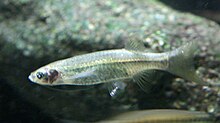
Puntius is a genus of small freshwater fish in the family Cyprinidae native to South Asia and Mainland Southeast Asia, as well as Taiwan.

Acanthurus is a genus of marine ray-finned fish belonging to the family Acanthuridae, which includes the surgeionfishes, unicornfishes and tangs, found in the Atlantic, Indian and Pacific Ocean. They are found in tropical oceans, especially near coral reefs, with most species in the Indo-Pacific but a few are found in the Atlantic Ocean. As other members of the family, they have a pair of spines, one on either side of the base of the tail which are dangerously sharp.

Chaetodon is a tropical fish genus in the family Chaetodontidae. Like their relatives, they are known as "butterflyfish". This genus is by far the largest among the Chaetodontidae, with about 90 living species included here, though most might warrant recognition as distinct genera.

Rasbora is a genus of fish in the family Cyprinidae. They are native to freshwater habitats in South and Southeast Asia, as well as southeast China. A single species, R. gerlachi, is only known from an old specimen that reputedly originated from Africa (Cameroon), but this locality is considered doubtful. They are small, up to 17 cm (6.7 in) long, although most species do not surpass 10 cm (4 in) and many have a dark horizontal stripe.

The Indian flying barb, historically flying barb, is one of the species known in the group flying barbs owing to their extremely long barbels. It was discovered as long ago as 1822 by Hamilton. However, it is rarely seen in aquaria. It is found in Myanmar, Nepal, Pakistan, Sri Lanka and India, it is found in many of the same localities as Danio rerio and Danio dangila, an example being the Jorai Rivulet, a tributary of the Sankosh river in Coochbehar district, West Bengal, India. The rare fish Borellius spp. is locally named "Boirali maach".

Barbonymus is a ray-finned fish genus in the family Cyprinidae, containing some barb species. The genus was only established in 1999, with the tinfoil barb as type species; thus, these fish are sometimes collectively called tinfoils. The new genus was established in recognition of the fact that some large Asian "barbs", formerly rather indiscriminately lumped in Barbus, Barbodes and Puntius, form a distinct evolutionary lineage.

Barbodes is a genus of small to medium-sized cyprinid fish native to tropical Asia. The majority of the species are from Southeast Asia. Many species are threatened and some from the Philippines are already extinct. A survey carried out in 1992 only found three of the endemic Barbodes species, and only two were found in 2008. Several members of this genus were formerly included in Puntius.

Osteochilus is a genus of cyprinid fishes mainly found in Southeast Asia with a few extending into adjacent parts of China. Additionally, two species are endemic to the Western Ghats in India.

Metynnis is a genus of serrasalmid fish from tropical and subtropical South America. They are herbivorous or omnivorous, and inhabit a wide range of freshwater habitats, ranging from rivers and streams, to floodplains, flooded forests, lakes, pools and reservoirs. They generally reach 8–15 cm (3–6 in) in standard length, although a few species may reach up to 18 cm (7 in). The genus contains many of the species known as silver dollars in the aquarium trade.

Pethia is a genus of small freshwater fish in the family Cyprinidae native to South Asia, East Asia and Mainland Southeast Asia. Some species are commonly seen in the aquarium trade. The name Pethia is derived from the Sinhalese "pethia", a generic word used to describe any of several small species of cyprinid fishes. Most members of this genus were included in Puntius, until it was revised in 2012.

Esomus metallicus, sometimes known as striped flying barb, is a species of cyprinid found in Southeast Asia, including the Salween, Mekong, and Chao Phraya river systems. It is found in fresh and brackish water. It grows to 7.5 cm (3.0 in) standard length.

Esomus thermoicos is a species of barb in the family Cyprinidae. It is found in freshwater streams, ponds and rivers of southern India and Sri Lanka. It is threatened by habitat loss. It is sometimes considered conspecific with the South Indian flying barb.

The Burmese flying barb is a species of cyprinid fish endemic to Myanmar.

The South Indian flying barb is a species of cyprinid endemic to India where it is found in drainages in the Eastern Ghats and Western Ghats. It is sometimes considered conspecific with Esomus thermoicos.
The striped flying barb is a species of cyprinid. It is found in Bangladesh, India, and Sri Lanka. Esomus metallicus is also sometimes known as the striped flying barb.
The Mekong flying barb is a species of cyprinid found in Mekong river basins in Thailand, Laos, Cambodia and Viet Nam.
The Malayan flying barb is a species of cyprinid found in Malaysia and Vietnam.














